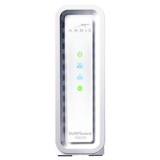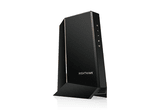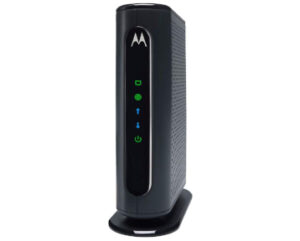DOCSIS 3.0 vs. DOCSIS 3.1: Which modem is right for you?
Do you need a DOCSIS 3.1 cable modem?
Sep 25, 2025 | Share
Technology
-
Best overallARRIS SURFboard SB8200
- $165.99
- Specs:
- DOCSIS 3.1
- 2Gbps max downstream
- 1Gbps max upstream
- 2 Gigabit Ethernet ports
- Compatible with Cox, Spectrum, & Xfinity
-
Best for gamingNETGEAR Nighthawk CM2000
- $298.05
- Specs:
- DOCSIS 3.1
- 2.5Gbps max downstream
- 1.5Gbps max upstream
- 1 Gigabit Ethernet port
- Compatible with Cox, Spectrum, & Xfinity
-
Best for budgetsMotorola MB7420
- $59.00
- Specs:
- DOCSIS 3.0
- 686Mbps max downstream
- 123Mbps max upstream
- 1 Gigabit Ethernet port
- Compatible with Cox, Spectrum, & Xfinity
DOCSIS is the standard that allows the internet to work over coaxial cables. New versions of DOCSIS come out periodically, always packing substantial upgrades for cable internet customers. Right now, DOCSIS 3.1 is the current standard used by nearly all cable ISPs, but not all modems are equipped to utilize the full power of DOCSIS 3.1.
You need a DOCSIS 3.1 cable modem to take full advantage of a gigabit (1,000 Mbps) internet plan with a cable internet service provider (ISP). If you don’t have a gigabit internet plan, a DOCSIS 3.1 modem isn’t necessary, though you may still see some benefits from using one. We’ll break down the key differences between DOCSIS 3.1 and DOCSIS 3.0 to help you figure out which is best for you.
DOCSIS 3.0
 Pros:
Pros:
- Cheap modems
 Cons:
Cons:
- Slower speeds (up to 1 Gbps)
- Not future-proof
DOCSIS 3.1
 Pros:
Pros:
- Faster speeds (up to 10Gbps)
- Improved latency
- Improved security
- Improved power efficiency
- Future-proof
 Cons:
Cons:
- Expensive modems
What is DOCSIS?
DOCSIS stands for Data Over Cable Service Interface Specifications. It’s the global standard that allows for the transfer of high-speed internet data over coaxial cable networks. Cable internet subscribers need a DOCSIS modem to interpret the signal coming from their internet provider.
DOCSIS 3.0
DOCSIS 3.0 came out in 2006 and is still the standard used by many modems. Its max download speed is 1Gbps. Most budget and mid-priced modems and modem/router combos (also called internet gateways) use DOCSIS 3.0.
DOCSIS 3.1
DOCSIS 3.1 came out in 2013 and is now the primary standard used by large cable ISPs. It’s ten times faster than DOCSIS 3.0 with a max download speed of 10Gbps. DOCSIS 3.1 also includes improved security features, lower latency, and more efficient power usage. DOCSIS 3.1 modems tend to be more expensive than DOCSIS 3.0 modems.
Benefits of DOCSIS 3.1 modems
Internet speeds faster than 1Gbps
DOCSIS 3.0
DOCSIS 3.0 came out in 2006 and is still the standard used by many modems. Its max download speed is 1Gbps. Most budget and mid-priced modems and modem/router combos (also called internet gateways) use DOCSIS 3.0.
DOCSIS 3.1
DOCSIS 3.1 came out in 2013 and is now the primary standard used by large cable ISPs. It’s ten times faster than DOCSIS 3.0 with a max download speed of 10Gbps. DOCSIS 3.1 also includes improved security features, lower latency, and more efficient power usage. DOCSIS 3.1 modems tend to be more expensive than DOCSIS 3.0 modems.
| Modem | Max download speed | Max upload speed |
|---|---|---|
| DOCSIS 3.1 | 10Gbps | 1Gbps |
| DOCSIS 3.0 | 1Gbps | 216Mbps |
| Modem | DOCSIS 3.1 |
| Max download speed | 10Gbps |
| Max upload speed | 1Gbps |
| Modem | DOCSIS 3.0 |
| Max download speed | 1Gbps |
| Max upload speed | 216Mbps |
You absolutely need a DOCSIS 3.1 modem to get speeds above 1Gbps from a cable internet provider. The older DOCSIS 3.0 maxes out at 1Gbps. If you have a faster internet plan that’s below 1,000Mbps, you don’t need a DOCSIS 3.1 modem, but it would likely perform better than a DOCSIS 3.0 modem, giving you more consistent speeds. Each ISP is a little different, but generally, any cable internet plan 500GB or above is likely to see improved performance with a DOCSIS 3.1 modem.
Lower Latency
DOCSIS 3.1 includes a technology called low latency DOCSIS that prioritizes latency-sensitive tasks and gives them a kind of internet fast lane. This reduces latency and provides a consistent, smooth experience for activities like online gaming and video calls.
Future-proof
With 10 Gbps bandwidth capability, DOCSIS 3.1 will be the preferred standard for a long while, and DOCSIS 3.0 is on the way out. All the big cable internet providers—like Cox, Spectrum, and Xfinity—already use DOCSIS 3.1, and before long, every cable ISP will likely use it.
This doesn’t mean your old DOCSIS 3.0 modem will become obsolete tomorrow, but its functionality may decrease as your ISP aligns its tech with DOCSIS 3.1. You may not be able to take full advantage of new features and faster plans. Even a general decline in performance over time, perhaps in the form of less consistent speeds or higher latency, is a strong possibility.
Who doesn’t need a DOCSIS 3.1 cable modem?
You don’t need a DOCSIS 3.1 modem if you have an internet plan with download speeds below 1,000Gbps. But if you have a faster internet plan (500Mbps & up), you’re still likely to benefit from one. A DOCSIS 3.1 modem can provide more consistent speeds, lower latency, and better security for any fast internet plan.
You don’t need DOCSIS 3.1 if your provider doesn’t use the DOCSIS 3.1 standard. This isn’t very common with cable ISPs. Before purchasing a modem, always check its compatibility with your service—there should be a list of compatible modems on your internet provider’s website.
If you’re trying to stick to a tight budget and don’t have a fast internet plan, a cheaper DOCSIS 3.0 modem is probably the better choice. The same goes for more casual internet users.
What’s next for DOCSIS?
There’s already a new DOCSIS version being deployed in the US: DOCSIS 4.0. DOCSIS 4.0’s main advantage is increased upload bandwidth and the capability for symmetrical bandwidth over cable internet connections—this may eventually lead to fiber losing it’s biggest advantage over cable. Don’t rush out to replace your internet equipment just yet, though. DOCSIS 4.0 deployment in the US is still years behind becoming the majority standard for internet customers. So far, only Xfinity has deployed the new tech in a few limited markets. In fact, it’s so early in the deployment timeline that manufactures have yet to release any consumer DOCSIS 4.0 hardware.
DOCSIS 4.0 is one part of the ambitious 10G internet initiative, a collaborative effort of the worlds top cable ISPs and organizations to eventually reach 10Gbps download speeds and 6Gbps upload speeds over coaxial lines.
Product FAQ
Do I need a DOCSIS 3.1 cable modem for a gigabit (1,000 Mbps) cable internet plan?
Yes. To take full advantage of gigabit speeds with cable ISP, a DOCSIS 3.1 modem is required. DOCSIS 3.0 can technically reach speeds up to 1,000Mbps, but that’s DOCSIS 3.0’s absolute speed limit. It’s unrealistic to expect consistent gigabit speeds from a DOCSIS 3.0 modem.
DOCSIS 3.1 can reach speeds up to 10Gbps, providing plenty of headroom for a gigabit internet plan.
Is DOCSIS 3.1 better for gaming?
Yes. Because DOCSIS 3.1 includes low latency DOCSIS (LLD) technology, it provides a smoother experience for delay-sensitive activities like online gaming and video calls.
Is a DOCSIS 3.1 modem necessary for internet plans below 1,000 Mbps?
No. The older DOCSIS 3.0 standard is capable of download speeds up to 1,000Mbps. However, a DOCSIS 3.1 modem can still provide increased performance on sub-gigabit internet plans.
What’s the best DOCSIS 3.1 modem?
The Motorola MB8600 and ARRIS SURFboard SB8200 are both excellent DOCSIS 3.1 cable modems. For gaming, the NETGEAR Nighthawk CM2000 is a great choice. Learn more in our breakdown of the best gigabit modems.
How many channels should my modem have?
It depends on your internet speed. For plans up to 500Mbps, you want at least 16×4, which means 16 downstream channels and 4 upstream channels. For plans with speeds above 500Mbps, we recommend 24×8, and for Gigabit speeds (1,000Mbps) and above, 32×8.
What is Docsis 4.0?
Docsis 4.0 is a powerful new protocol that will allow for much faster upload speeds over coaxial cables. The gigabit upstream speeds of DOCSIS 3.1 were already a huge leap over previous versions, but DOCSIS 4.0 can reach upload speeds of 6Gbps, which is on par with upload speeds offered by some of the fastest fiber plans out there. DOCSIS 4.0 is so new that isn’t widely available yet.
Author - Austin Aguirre
Austin worked as a broadband technician installing and troubleshooting countless home internet networks for some of the largest ISPs in the U.S. He became a freelance writer in 2020 specializing in software guides. After graduating with a BS in technical communication from Arizona State University, he joined the team at HighSpeedInternet.com where he focuses on home network improvement and troubleshooting.
Editor - Rebecca Lee Armstrong
Rebecca Lee Armstrong has more than six years of experience writing about tech and the internet, with a specialty in hands-on testing. She started writing tech product and service reviews while finishing her BFA in creative writing at the University of Evansville and has found her niche writing about home networking, routers, and internet access at HighSpeedInternet.com. Her work has also been featured on Top Ten Reviews, MacSources, Windows Central, Android Central, Best Company, TechnoFAQ, and iMore.











